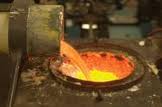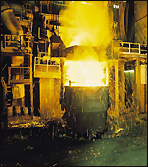The melting point of a solid is the temperature at which the vapor pressure of the solid and the liquid are equal. At the melting point the solid and liquid phase exist in equilibrium. When considered as the temperature of the reverse change from liquid to solid, it is referred to as the freezing point or crystalization point. Because of the ability of some substances to supercool, the freezing point is not considered to be a characteristic property of a substance. When the "characteristic freezing point" of a substance is determined, in fact the actual methodology is almost always "the principle of observing the disappearance rather than the formation of ice", that is, the melting point.

Many laboratory techniques exist for the determination of melting points. A Kofler is a metal strip with a temperature gradient (range room temperature to 300 °C). Any substance can be placed on a section of the strip revealing its thermal behavior at the temperature at that point. Differential scanning calorimetry gives information on melting point together with its enthalpy of fusion.
A basic melting point apparatus for the analysis of crystalline solids consists of a oil bath with a transparent window (most basic design: a theile tube) and a simple magnifier. The several grains of a solid are placed in a thin glass tube and partially immersed in the oil bath. The oil bath is heated (and stirred) and with the aid of the magnifier (and external light source) melting of the individual crystals at a certain temperature can be observed. In large/small devices, the sample is placed in a heating block, and optical detection is automated.
Metal Melting Points

Thermometrics, our guiding objectives are Customer Satisfaction and Continuous Improvement. We accomplish this through monitoring our systems, measuring our performance and employee development. Our goal is to continually work at being the most successful company in the world, in delivering the highest quality of products, technology, competitive pricing, continuous customer service and satisfaction.
| Metal | Melting Point (Deg F) |
|---|---|
| mild steel | 2730 |
| wrought iron | 2700-2900 |
| stainless steel | 2600 |
| hard steel | 2555 |
| cast iron | 2060-2200 |
| copper | 1985 |
| red brass | 1832 |
| silver | 1763 |
| yellow brass | 1706 |
| aluminum alloy | 865-1240 |
| magnesium alloy | 660-1200 |
| lead | 621 |
| babbit | 480 |